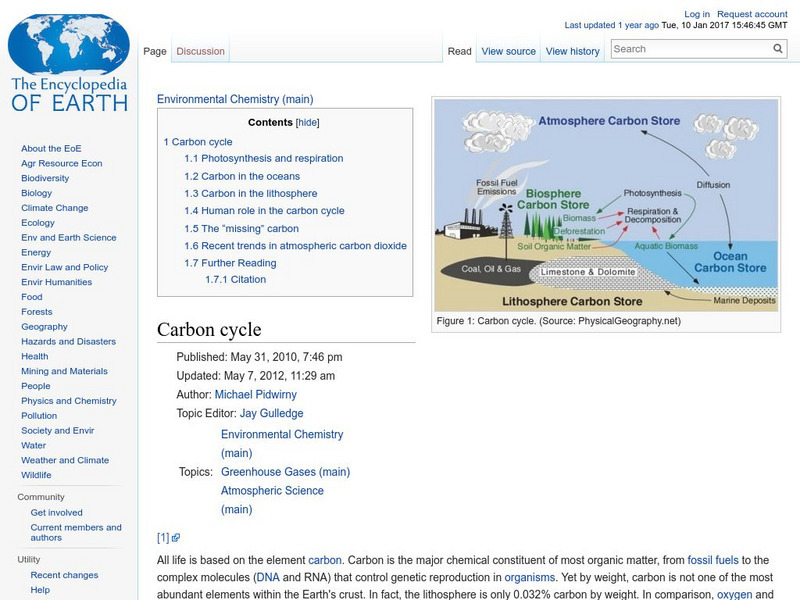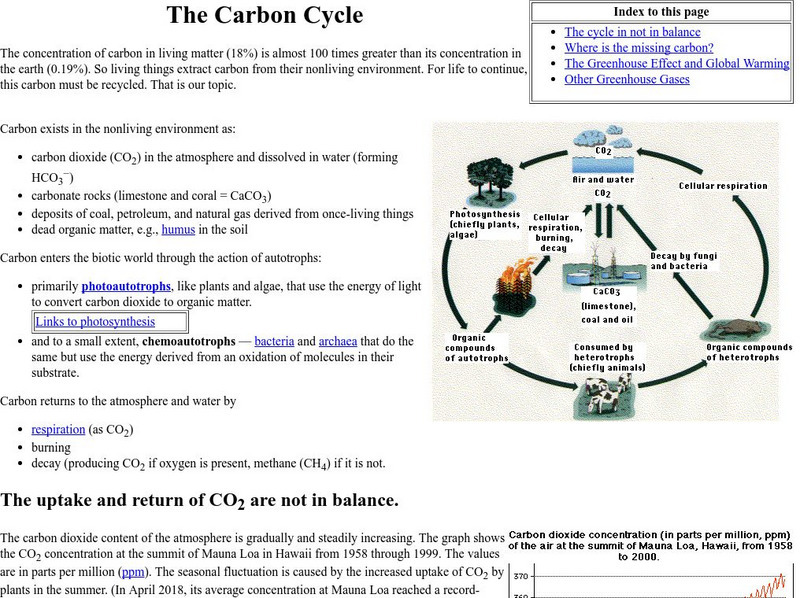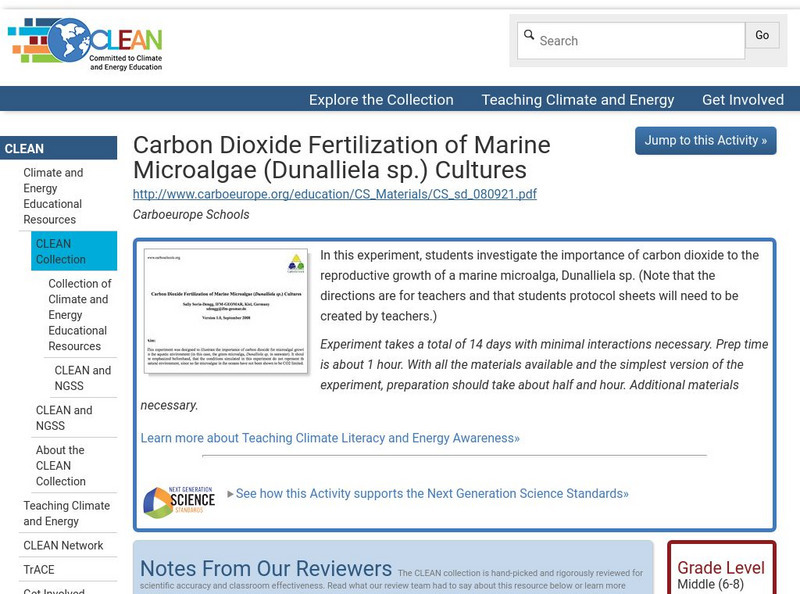Curated OER
Chemistry Module 5 - Specifications
While this resource does not provide problems for chemistry learners to solve, it outlines skills that they should have and concepts that they should grasp. Topics include thermodynamics, periodicity, redox equilibria, transition metals,...
Curated OER
What Should I Know about Respiration
How are kids supposed to know what to study for that cellular respiration test? With a study guide or reading guide like the one found here. With three pages of questions important to the understanding of respiration and the processes...
Curated OER
The Effects of Photosynthesis on Plant Growth
Students examine the process of photosynthesis; its products and reactants, and the sequence of the process. They diagram the light reactions, record observations of plants, and discuss how difficult it is to measure plant growth as it...
Curated OER
Reactions of Photosynthesis
If you are looking for a simple quiz that delves deeper into the photosynthesis process, you found it! Fill in the blanks, graph and diagram interpretation, multiple choice, true/false, and short answer are all included in this...
Curated OER
AMPHIBIAN RESPIRATION
High schoolers describe the structural differences in the respiratory systems of aquatic and terrestrial vertebrates and explain the motivation for these structural adaptations in reference to the differences in habitat.
Curated OER
Anatomy Review: The Heart
In this anatomy review worksheet, students read through notes over the heart, label 11 diagrams and complete 7 review questions.
Curated OER
Respiration
In this science worksheet, students answer 14 questions about respiration. For example, "Cellular Respiration starts off with..."
Curated OER
Energy in a Cell
For this cell energy worksheet, students are given clues about the light capturing process in plants and the energy producing reactions in animals to complete a crossword puzzle.
Curated OER
Tree Friends
Students are introduced to tree structure and use. They identify their special tree using all senses except sight. Students identify six different internal parts within a cross section of tree trunk (bark, phloem, xylem, cambium,...
Curated OER
Beaver Ecology
Students explore the lives of bgeahvers. They identify the physical and behavioral adaptations that help beavers survive in their environment. Students compare and contrast how beavers influence the ecology of both forest and aquatic...
Curated OER
Plant Science: Introduction to Photosynthesis
Students explore the process of photosynthesis in plants. They discuss the purpose of photosynthesis and its components. Students discuss the importance of photosynthesis for plants and they examine the parts of the plant that play an...
Curated OER
What We As Students Can Do To Save Our World
Students investigate air and water pollution, and the conservation of natural resources.
Curated OER
What's Making It Look So Brown Outside?
Ninth graders analyze cars and particulate matter in the atmosphere. They analyze results of particulate pollutants and identify which vehicle gives off more particulates. They identify sources of particulate matter and relate to...
Curated OER
It's Okay to Exhale: Photosynthesis and Cellular Respiration
Students will observe the differences between photosynthesis and cellular respiration. Then they observe the links due to climate changes and relate how climate change affects their lives.
Curated OER
Weather "Toons
Student use a variety of resources including print, CD-Rom and Internet information to study a weather process. They design a weather cartoon citing the bibliographic sources from their research.
Curated OER
The Environment: Vocabulary
In this environment vocabulary worksheet, learners complete 12 multiple choice questions, then translate a set of "environment words."
Encyclopedia of Earth
Encyclopedia of Earth: Environmental Chemistry: Carbon Cycle
Article explaining the importance of carbon as the basis for life, carbon dioxide's role in photosynthesis and respiration, carbon in the ocean and lithosphere, the impact of human activities on the carbon cycle, carbon that seems to be...
TED Talks
Ted: Ted Ed: The Carbon Cycle
Video talks about the carbon cycle and uses a computer as a metaphor to show how the cycle can be disrupted by climate change. [3:55] Includes a short quiz and a list of additional resources to explore.
University Corporation for Atmospheric Research
Ucar: The Carbon Cycle
A comprehensive introduction to the carbon cycle. The cycle of atoms between living and non-living things is known as a biogeochemical cycle. The most common of these are the carbon and nitrogen cycles.
Biology Pages
Kimball's Biology Pages: The Carbon Cycle
Useful introduction to the carbon cycle with a diagram and a discussion of the effects of carbon dioxide on the greenhouse effect and global warming.
TeachEngineering
Teach Engineering: Carbon Cycles
Students are introduced to the concept of energy cycles by learning about the carbon cycle. They will learn how carbon atoms travel through the geological (ancient) carbon cycle and the biological/physical carbon cycle. Students will...
Climate Literacy
Clean: Carbon Dioxide Sources and Sinks
In this lab activity, students use a chemical indicator (bromothymol blue) to detect the presence of carbon dioxide in animal and plant respiration and in the burning of fossil fuels and its absence in the products of plant...
Climate Literacy
Clean: Carbon Dioxide Fertilization of Marine Microalgae Cultures
In this experiment, students investigate the importance of carbon dioxide to the reproductive growth of a marine microalga, Dunalliela sp.
Center for Innovation in Engineering and Science Education, Stevens Institute of Technology
Ciese: Carbon Imbalance: Algae to the Rescue? [Pdf]
A 95-page learning module that integrates biology, chemistry, and engineering. It includes in-class labs, virtual labs, and engineering design activities. Working with algae, students learn about and investigate how photosynthesis,...
Other popular searches
- Oxygen Carbon Dioxide Cycle
- Oxygen, Carbon Dioxide Cycle
- Oxygen Carbon Dioxide Cycle
- Oxygen Carbon Dioxide Cycle
- Oxygen Carbon Dioxide Cycle























![Ciese: Carbon Imbalance: Algae to the Rescue? [Pdf] Unit Plan Ciese: Carbon Imbalance: Algae to the Rescue? [Pdf] Unit Plan](http://lessonplanet.com/content/resources/thumbnails/455842/large/bwluav9tywdpy2symdizmdeyny0xmdcynjyylwcwy3uxni5qcgc.jpg?1674855345)